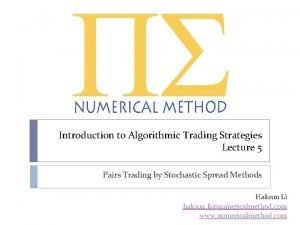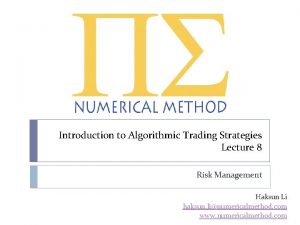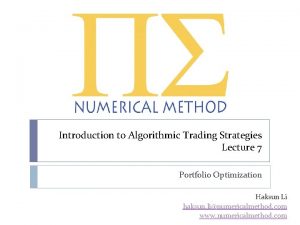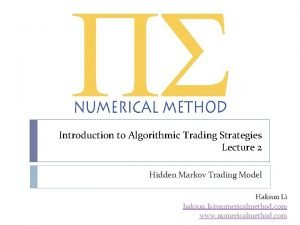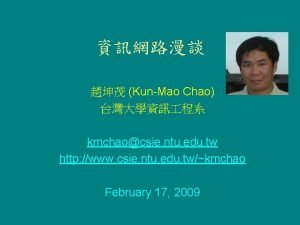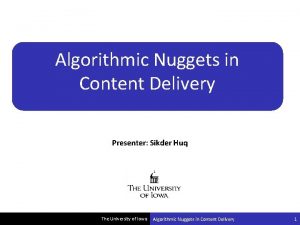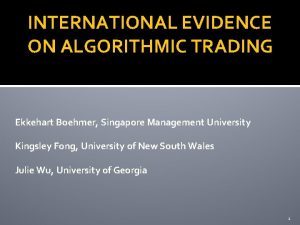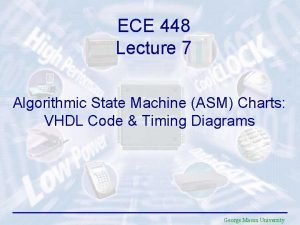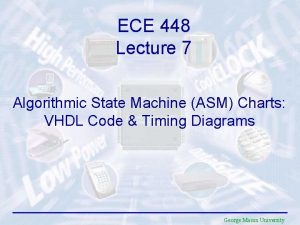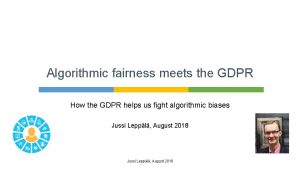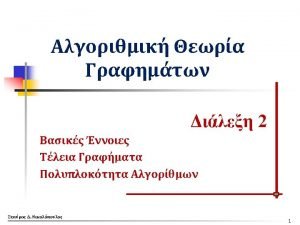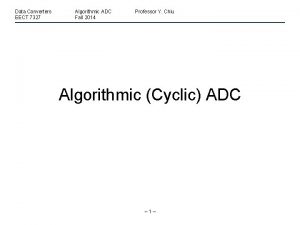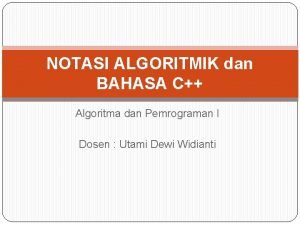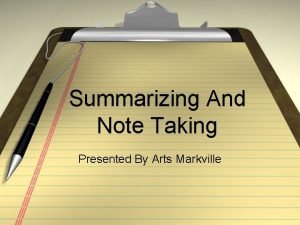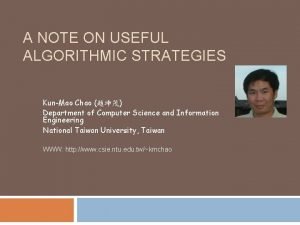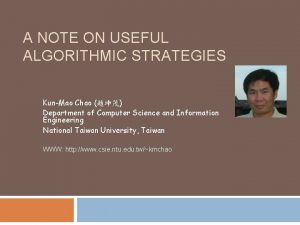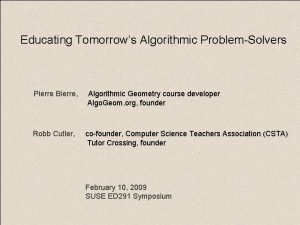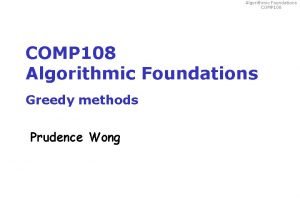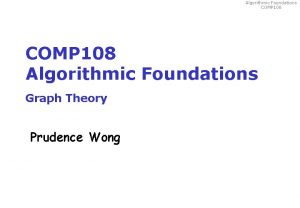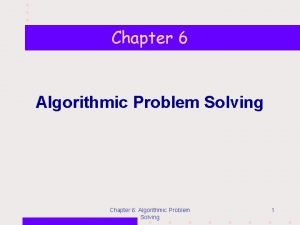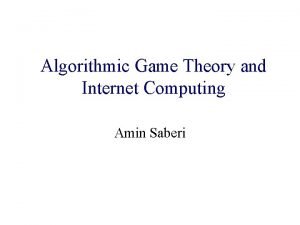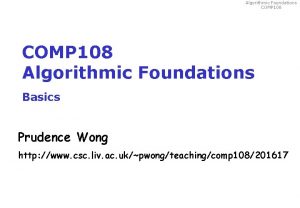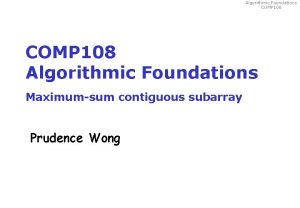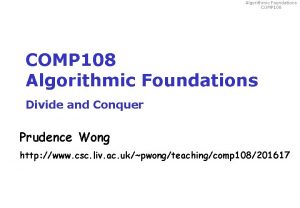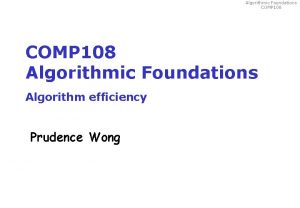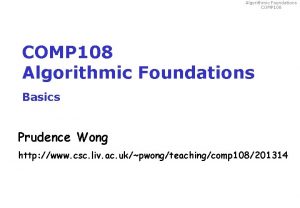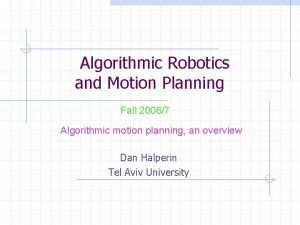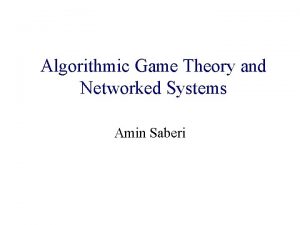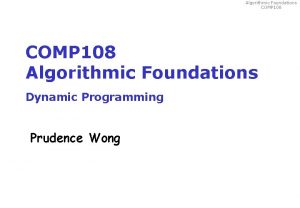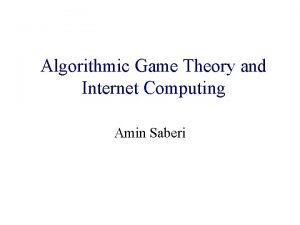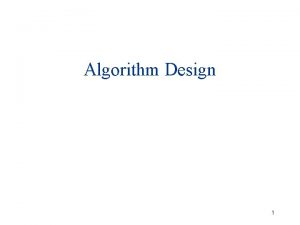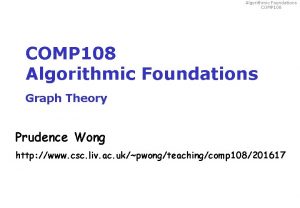A Quick Note on Useful Algorithmic Strategies KunMao
















![A naive approach for LIS • Let L[i] be the length of a longest A naive approach for LIS • Let L[i] be the length of a longest](https://slidetodoc.com/presentation_image_h2/da2d5f324992d7c6f20f62417b2f9330/image-17.jpg)
![A naive approach for LIS L[i] = 1 + max j = 0. . A naive approach for LIS L[i] = 1 + max j = 0. .](https://slidetodoc.com/presentation_image_h2/da2d5f324992d7c6f20f62417b2f9330/image-18.jpg)
![An O(n log n) method for LIS • Define Best. End[k] to be the An O(n log n) method for LIS • Define Best. End[k] to be the](https://slidetodoc.com/presentation_image_h2/da2d5f324992d7c6f20f62417b2f9330/image-19.jpg)
![An O(n log n) method for LIS • Define Best. End[k] to be the An O(n log n) method for LIS • Define Best. End[k] to be the](https://slidetodoc.com/presentation_image_h2/da2d5f324992d7c6f20f62417b2f9330/image-20.jpg)









- Slides: 29

A Quick Note on Useful Algorithmic Strategies Kun-Mao Chao (趙坤茂) Department of Computer Science and Information Engineering National Taiwan University, Taiwan WWW: http: //www. csie. ntu. edu. tw/~kmchao

Greedy Algorithm • A greedy method always makes a locally optimal (greedy) choice. – the greedy-choice property: a globally optimal solution can be reached by a greedy choice. – optimal substructures 2

Huffman Codes (1952) David Huffman (August 9, 1925 – October 7, 1999) 3

Huffman Codes Expected number of bits per character = 3 x 0. 1+2 x 0. 3+1 x 0. 5 = 1. 7 (vs. 2 bits by a simple scheme) 4

An example Sequence: GTTGTTATCGTTTATGTGGC By Huffman Coding: 011100010010111100010110101001 20 characters; 34 bits in total 5

Divide-and-Conquer 1. Divide the problem into smaller subproblems. 2. Conquer each subproblem recursively. 3. Combine the solutions to the child subproblems into the solution for the parent problem. 6

Merge Sort (Invented in 1938; Coded in 1945) John von Neumann (December 28, 1903 – February 8, 1957 ) 7

Merge Sort (Merge two solutions into one. ) 8

Merge Sort 9

Dynamic Programming • Dynamic programming is a class of solution methods for solving sequential decision problems with a compositional cost structure. • Richard Bellman was one of the principal founders of this approach. Richard Ernest Bellman (1920– 1984) 10

Two key ingredients • Two key ingredients for an optimization problem to be suitable for a dynamicprogramming solution: 1. optimal substructures 2. overlapping subproblems Subproblems are dependent. Each substructure is optimal. (otherwise, a divide-andconquer approach is the (Principle of optimality) 11 choice. )

Three basic components • The development of a dynamicprogramming algorithm has three basic components: – The recurrence relation (for defining the value of an optimal solution); – The tabular computation (for computing the value of an optimal solution); – The traceback (for delivering an optimal solution). 12

Fibonacci numbers The Fibonacci numbers are defined by the following recurrence: F =0 0 F =1 1 F = F - + F - for i>1. i i 1 i 2 Leonardo of Pisa (c. 1170 – c. 1250) 0, 1, 1, 2, 3, 5, 8, 13, 21, 34, 55, 89, 144, 233, 377, 610, 987, 1597, 2584, 4181, 6765, 10946, 17711, 28657, 46368, 75025, 121393, . . . 13

How to compute F 10? F 10 F 9 F 8 F 7 …… F 7 F 6 14

Tabular computation • The tabular computation can avoid recompuation. F 0 F 1 F 2 F 3 F 4 F 5 F 6 F 7 F 8 F 9 F 10 0 1 1 2 3 5 8 13 21 34 55 15

Longest increasing subsequence(LIS) • The longest increasing subsequence is to find a longest increasing subsequence of a given sequence of distinct integers a 1 a 2…an. e. g. 9 2 5 3 7 11 8 10 13 6 2 3 7 5 7 10 13 9 7 11 10 3 5 11 13 are increasing subsequences. We want to find a longest one. are not increasing subsequences. 16
![A naive approach for LIS Let Li be the length of a longest A naive approach for LIS • Let L[i] be the length of a longest](https://slidetodoc.com/presentation_image_h2/da2d5f324992d7c6f20f62417b2f9330/image-17.jpg)
A naive approach for LIS • Let L[i] be the length of a longest increasing subsequence ending at position i. L[i] = 1 + max j = 0. . i-1{L[j] | aj < ai} (use a dummy a 0 = minimum, and L[0]=0) 9 2 5 3 7 11 8 10 13 6 L[i] 1 1 2 2 3 4 ? 17
![A naive approach for LIS Li 1 max j 0 A naive approach for LIS L[i] = 1 + max j = 0. .](https://slidetodoc.com/presentation_image_h2/da2d5f324992d7c6f20f62417b2f9330/image-18.jpg)
A naive approach for LIS L[i] = 1 + max j = 0. . i-1 {L[j] | aj < ai} 9 2 5 3 7 11 8 10 13 6 L[i] 1 1 2 2 3 4 4 5 6 3 The maximum length The subsequence 2, 3, 7, 8, 10, 13 is a longest increasing subsequence. This method runs in O(n 2) time. 18
![An On log n method for LIS Define Best Endk to be the An O(n log n) method for LIS • Define Best. End[k] to be the](https://slidetodoc.com/presentation_image_h2/da2d5f324992d7c6f20f62417b2f9330/image-19.jpg)
An O(n log n) method for LIS • Define Best. End[k] to be the smallest number of an increasing subsequence of length k. 9 2 5 3 7 11 8 10 13 9 2 2 3 7 11 2 3 7 8 10 13 2 5 2 3 7 6 Best. End[1] Best. End[2] Best. End[3] Best. End[4] Best. End[5] Best. End[6] 19
![An On log n method for LIS Define Best Endk to be the An O(n log n) method for LIS • Define Best. End[k] to be the](https://slidetodoc.com/presentation_image_h2/da2d5f324992d7c6f20f62417b2f9330/image-20.jpg)
An O(n log n) method for LIS • Define Best. End[k] to be the smallest number of an increasing subsequence of length k. 9 2 5 3 7 11 8 10 13 9 2 2 3 7 11 2 3 7 8 10 13 2 5 2 3 7 For each position, we perform a binary search to update Best. End. Therefore, the running time is O(n log n). 6 2 3 6 8 10 13 Best. End[1] Best. End[2] Best. End[3] Best. End[4] Best. End[5] Best. End[6] 20

Longest Common Subsequence (LCS) • A subsequence of a sequence S is obtained by deleting zero or more symbols from S. For example, the following are all subsequences of “president”: pred, sdn, predent. • The longest common subsequence problem is to find a maximum-length common subsequence between two sequences. 23

LCS For instance, Sequence 1: president Sequence 2: providence Its LCS is priden. president providence 24

LCS Another example: Sequence 1: algorithm Sequence 2: alignment One of its LCS is algm. a l g o r i t h m a l i g n m e n t 25

How to compute LCS? • Let A=a 1 a 2…am and B=b 1 b 2…bn. • len(i, j): the length of an LCS between a 1 a 2…ai and b 1 b 2…bj • With proper initializations, len(i, j)can be computed as follows. 26

27

28

29

30

Longest Common Increasing Subsequence • Proposed by Yang, Huang and Chao – IPL 2005 • Improvement for some special case: – Katriel and Kutz (March 2005) – Chan, Zhang, Fung, Ye and Zhu (ISAAC 2005) 31
 Introduction to algorithmic trading strategies
Introduction to algorithmic trading strategies Introduction to algorithmic trading strategies
Introduction to algorithmic trading strategies Introduction to algorithmic trading strategies
Introduction to algorithmic trading strategies Introduction to algorithmic trading strategies
Introduction to algorithmic trading strategies Kunmao
Kunmao The fan blade is speeding up. what are the signs of
The fan blade is speeding up. what are the signs of Quick find vs quick union
Quick find vs quick union Goods received note vs delivery note
Goods received note vs delivery note Simple interest note vs simple discount note
Simple interest note vs simple discount note Difference between note making and note taking
Difference between note making and note taking Debit note format
Debit note format Example of signal word
Example of signal word Debit memo
Debit memo Difference between note making and note taking
Difference between note making and note taking Note taking and note making
Note taking and note making Simple event correlator
Simple event correlator Algorithmic nuggets in content delivery
Algorithmic nuggets in content delivery Algorithm input output example
Algorithm input output example Algorithmic trading singapore
Algorithmic trading singapore Asm
Asm Algorithmic cost modelling
Algorithmic cost modelling Ireallytrade.com
Ireallytrade.com Asm chart example problems
Asm chart example problems Gdpr algorithmic bias
Gdpr algorithmic bias Algorithmic graph theory and perfect graphs
Algorithmic graph theory and perfect graphs Algorithmic adc
Algorithmic adc Abstraction gcse computer science
Abstraction gcse computer science Contoh algoritma bahasa c
Contoh algoritma bahasa c Aha moment notice and note
Aha moment notice and note Summarizing and note taking strategies
Summarizing and note taking strategies
